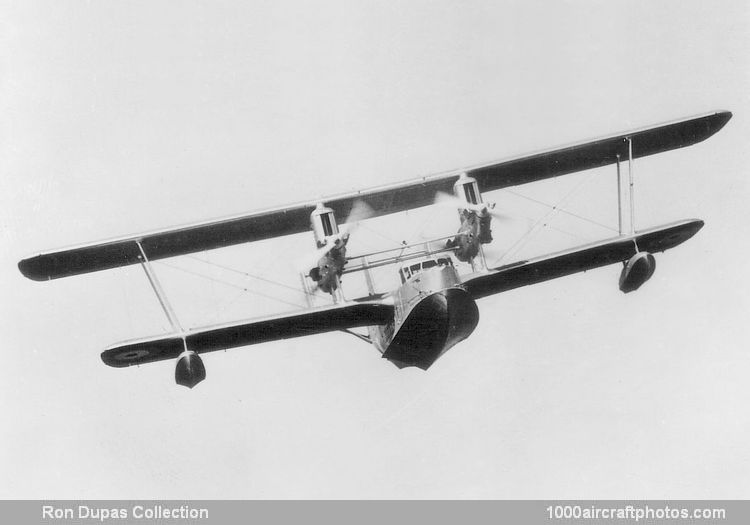01/31/2017. Remarks by Johan Visschedijk: "In August 1933, the Air Ministry placed a development contract with Short Brothers, to Specification R.3/33, for four pre-production models of the Singapore Mk.II. These were built as the Singapore Mk.III, the last of the Short biplane flying boats. Serials allocated to the batch were K3592 to K3595 (c/n S.770 to S.773), with K3592 making its first flight on June 15, 1934. These first four machines were fitted with two 640 hp Rolls-Royce Kestrel IIMS tractor engines and two 640 hp Kestrel IIIMS pushers, with individual stub exhaust pipes in place of the common pipes of the Singapore Mk.II, and a more aerodynamically clean radiator system. In 1934 a new specification, R.4/34, was issued for a fully developed production version, fitted with 730 hp Kestrel IX and Kestrel VIII Kestrel engines.
The Singapore Mk.III differed from the final version of the Singapore Mk.II mainly in having blunter wing tips and a deeper hull of revised internal layout, having numerous openable port-holes and a large crew entry door on the starboard side aft of the pilots' cockpit; the wing tip floats were larger and closer to the wing, and the waist cockpit was wide enough to span the hull. The characteristic sweepback was retained, and the main fuel tanks occupied the full-span of the upper center section, overload fuel only being carried in the lower wing roots; all the tanks were of stainless steel, and the overload fuel could be jettisoned; the Handley Page auto-slots initially fitted to the Singapore Mk.II had been deleted at an early stage and did not reappear in the Singapore Mk.III.
Operated by a crew of six, the Singapore Mk.III attained a maximum speed of 145 mph at 2,000 ft (233 kmh at 610 m), with an initial rate of climb of 700 ft (213 m)/min, had a service ceiling of 15,000 ft (4,572 m), a range of 1,000 mls (1,609 km) in still air and an alighting speed of 65 mph (105 kmh).
Between 1934 and 1936, a total of 33 production aircraft were ordered, these were serialed K4577 to K4585 (c/n S.781 to S.784 and S.789 to S.802), K6907 to K6922 (c/n S.805 to S.809 and S.823 to S.833), K8565 to K8568 (c/n S.852 to S.855) and K8856 to K8859 (c/n S.856 to S.859). K4577 was first flown on March 8, 1935 and RAF No. 230 Squadron received their first Singapore Mk.IIIs at Pembroke Dock in April 1935. In August 1935, K4581 was flown from Felixstowe, UK to Seletar, Singapore, by Sqn/Ldr Plenderleith, making the first delivery to No. 205 Squadron, the event being much publicized in the press and on film. March 1936 saw No. 230 Squadron airborne in their machines, en route to Seletar to join No. 205, while Nos. 203, 209, 210 and 240 Squadrons were re-equipping with the Singapore Mk.III in the UK, No. 203's machines going to Iraq to replace their Rangoons.
1936 also saw a masterly forced landing carried out by the pilot of K4580 on a tree-surrounded lake at Hever in Kent, following the loss of some tail support struts. A crew flying over Iraq, probably of No. 203 Squadron, had a hair-raising experience when the tail incidence gear fractured in flight, causing the machine to alternately dive and climb until the offending member could be lashed with a spare control cable from the rear gunner's cockpit.
In September 1937, machines of Nos. 209 and 210 Squadrons were sent to Malta to carry out special patrols for the protection of British shipping during the Spanish Civil War, returning to England in December 1937. A number of Singapore Mk.IIIs remained on active service in the UK for a short period after the outbreak of WW II and the type continued in service in the Far East until 1941, three machines being detached from No. 205 Squadron to form the sole air defense of Fiji."
